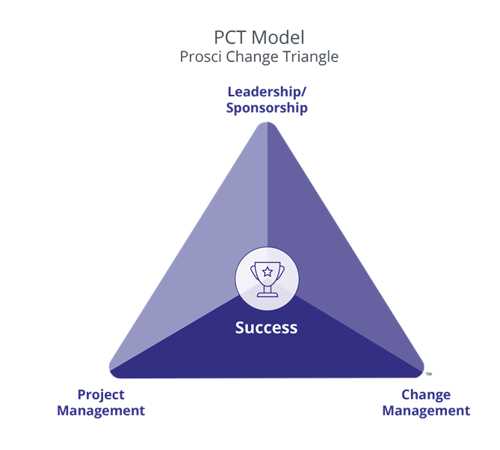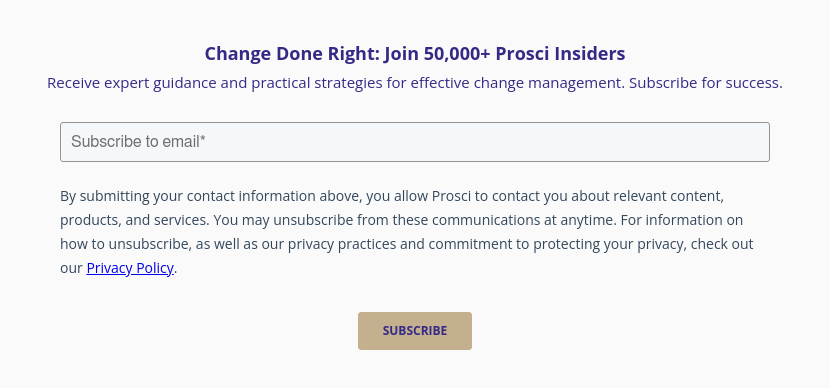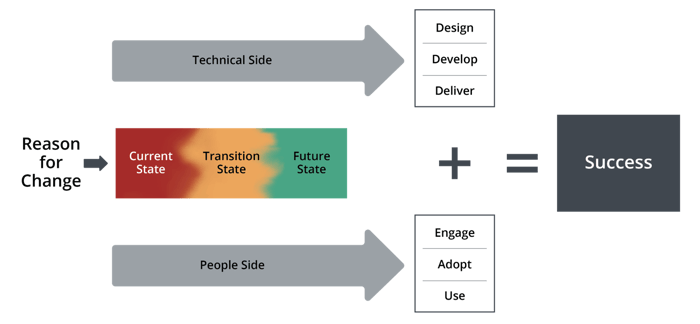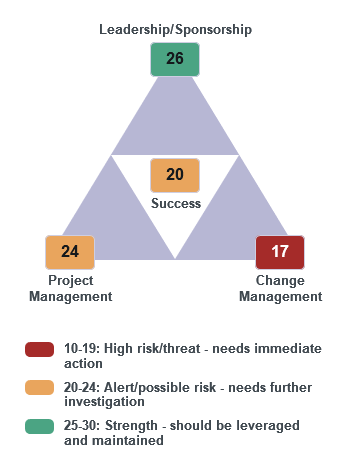Start Projects With the PCT Model Like an Experienced Change Leader

4 Mins
Updated: August 27, 2025
Published: December 14, 2022

How do you define project health? Have you taken time to think about what you need from the organization to deliver successful change?
After creating your business case for change management, you can use the Prosci Change Triangle (PCT) Model to start to measure and track your project’s overall health. Here’s a step-by-step approach.
Start With a Business Case and the PCT Model
When I create a basic business case for change management on a project, I typically include at least the following elements:
- Definition of the problem
- Proposed solution
- Summary of the project benefits, financials and ROI
- High-level project timeline with key phases and milestones
- Link to corporate strategy and a project risk assessment
Once the business case has been approved, the project must be tracked to understand overall performance as compared to the benefits, financials and timelines identified within the original business case. However, these measures only track performance of the outcomes promised in the business case. Although they’re certainly important, they do not provide a holistic view of what is required to ensure healthy, successful projects.
Prosci’s change management research helps us understand what a healthy project needs to succeed, and it's the basis for the Prosci Change Triangle (PCT) Model, a framework that shows the four critical aspects of a successful change effort and how they interrelate:
- Success – focused on defining project benefits and objectives
- Leadership/sponsorship – focused on governance, direction, decisions and actions
- Project management – focused on time, cost, scope, design, develop and deliver
- Change management – focused on individual and organizational change, engagement, adoption and usage

Track and Gauge Project Health
The PCT Model and Assessment are invaluable for ensuring your project success. To track and gauge project health over the course of a project, change leaders often apply the PCT Assessment at project initiation, various points in the middle, and again at the end.
Let me explain how I leverage the tool at the commencement of a project, starting with an assessment.
The PCT Model and PCT Assessment at project initiation
Upon joining the project team as the change lead, I introduce the PCT Model and use the PCT Assessment to effectively accomplish three early outcomes:
- Reach alignment about the key aspects of project success, ensuring that all four elements of the PCT Model have been adequately defined
- Articulate the role of change management and where the discipline resides within the overall project or program
- Obtain a baseline measure of project health and identify the key next steps required by the change lead and other project team leaders
The PCT Assessment for setting context
The critical first step is to introduce the project leader to the PCT Assessment and engage them in using it. This means I need to provide context for the tool and its purpose, which is to measure our current performance against the four key elements of project success. Note that it’s not a change management tool that focuses solely on aspects of organizational change management. The PCT Assessment is a holistic project management and program management tool.

What I normally find is that a competent project leader or program manager will already have a list of actions required to successfully initiate their program. The goal is not to override this list, but to facilitate a broader conversation about the key elements that drive overall project success.
Prosci's Unified Value Proposition

Again, the PCT Assessment is not a tool to be owned and used by the change lead. Instead, the goal is for this tool to be owned and used by the project leadership team, project management office, or both throughout the entire project’s journey.
The PCT Assessment and defining success
Once the tool has been introduced, the second step is to get into the detail. I use the PCT Assessment to facilitate a conversation and agree on what “good” looks like for the project.
The PCT Assessment includes 40 questions that address the four key elements of project success and requires you to rank responses on a 1 to 3 scale. 1 = inadequate, 2 = adequate and 3 = exceptional. Naturally, the higher the ranking, the better you’re positioned for project success. The lower rankings drive conversations about actions required for improvement.
As indicated above, I usually perform the first assessment directly with the project leader or program leader because it is important to allow them time to become familiar with the tool and review the questions in significant detail. We discuss what good looks like in terms of success, leadership/sponsorship, project management and change management.
This is a critical conversation because it starts to set the expectations of what the project leader or program leader will want to see from key project team members throughout the program.
Identify actions and targets with the PCT Assessment
The third step is to identify actions and targets. It probably won’t surprise you to know that when you perform the PCT Assessment at the start of the project, the two key elements that normally score higher are success and project management. This is often because the project’s business case required more detailed thinking and planning around these elements. However, because it’s only the start of the project, I would expect all elements to be lower than where we would want them to be in the longer term.

As I progress through each question with the project leader, it is also an opportunity to discuss timing. Specifically, we need to agree on the point in our project at which we expect specific questions to be answered in their entirety. This conversation provides the ability to place timing against the PCT Assessment and forecast the expected results of future assessments. This can then be used as an actual-versus-forecast KPI.
The PCT Model and commitment from project leadership
The final step is to work with leadership to get their ongoing support for using the PCT Assessment to measure project health. Throughout this initial PCT Assessment, it is important to keep an eye on the key purpose and outcomes we are attempting to achieve.
I normally aim for the following outcomes:
- Clarify and align on what project success looks like
- Agree on ownership of the tool by the project leader, frequency of future PCT Assessments, and who from the broader project group should be involved
- Develop a forecast of what future PCT Assessment results should look like and the timing we expect
- Create a clear action plan, outlining next steps
- Commence a partnership with the project leader
Because I am the change lead in this scenario, the PCT Assessment provides a strong baseline for future organizational change activities in the action plan mentioned above. And because organizational change is only one of the four elements to project success, the partnership we begin in this final step helps to ensure that the project leader will be accountable for all four elements.
Ultimately, the goal is for the project leader to have a far clearer and more detailed understanding about the four key elements of project success and what will be required to achieve it.
The Prosci Change Triangle (PCT) Model
and PCT Assessment
As an experienced Prosci Certified Change Practitioner, I use the PCT Model and PCT Assessment to track and measure aspects of a project’s health beyond the success measures defined in a business case. It’s an especially useful tool for engaging and aligning stakeholders during the change process. And once you set a baseline with the PCT Assessment at the start of your project, you’ll have a clear starting point against which to measure project health throughout the project lifecycle.



